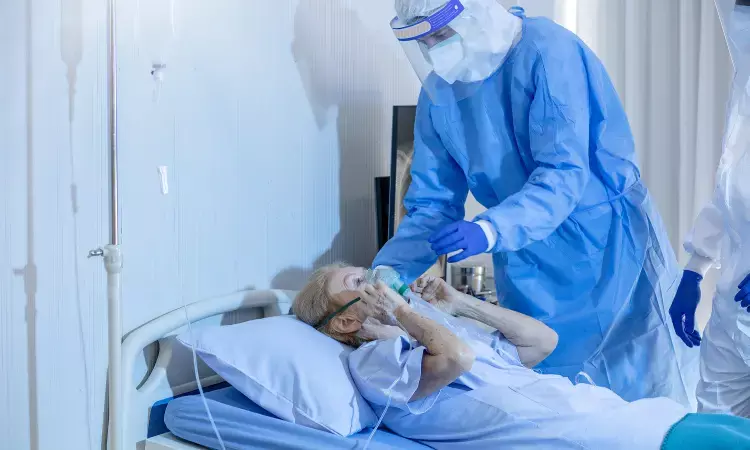- Home
- Medical news & Guidelines
- Anesthesiology
- Cardiology and CTVS
- Critical Care
- Dentistry
- Dermatology
- Diabetes and Endocrinology
- ENT
- Gastroenterology
- Medicine
- Nephrology
- Neurology
- Obstretics-Gynaecology
- Oncology
- Ophthalmology
- Orthopaedics
- Pediatrics-Neonatology
- Psychiatry
- Pulmonology
- Radiology
- Surgery
- Urology
- Laboratory Medicine
- Diet
- Nursing
- Paramedical
- Physiotherapy
- Health news
- Fact Check
- Bone Health Fact Check
- Brain Health Fact Check
- Cancer Related Fact Check
- Child Care Fact Check
- Dental and oral health fact check
- Diabetes and metabolic health fact check
- Diet and Nutrition Fact Check
- Eye and ENT Care Fact Check
- Fitness fact check
- Gut health fact check
- Heart health fact check
- Kidney health fact check
- Medical education fact check
- Men's health fact check
- Respiratory fact check
- Skin and hair care fact check
- Vaccine and Immunization fact check
- Women's health fact check
- AYUSH
- State News
- Andaman and Nicobar Islands
- Andhra Pradesh
- Arunachal Pradesh
- Assam
- Bihar
- Chandigarh
- Chattisgarh
- Dadra and Nagar Haveli
- Daman and Diu
- Delhi
- Goa
- Gujarat
- Haryana
- Himachal Pradesh
- Jammu & Kashmir
- Jharkhand
- Karnataka
- Kerala
- Ladakh
- Lakshadweep
- Madhya Pradesh
- Maharashtra
- Manipur
- Meghalaya
- Mizoram
- Nagaland
- Odisha
- Puducherry
- Punjab
- Rajasthan
- Sikkim
- Tamil Nadu
- Telangana
- Tripura
- Uttar Pradesh
- Uttrakhand
- West Bengal
- Medical Education
- Industry
Reducing patients' breathing efforts key to success of non-invasive respiratory support in COVID-19 patients

Engineering researchers from the University of Warwick, and their team of international experts from the UK, US and Ireland, are the first to use computational modelling to compare the effectiveness of conventional oxygen therapy (COT), high-flow nasal oxygen therapy (HFNOT), continuous positive airway pressure (CPAP), and non-invasive ventilation (NIV).
In a paper, 'Optimising respiratory support for early COVID-19 pneumonia: a computational modelling study', published in the British Journal of Anaesthesia, researchers from the University of Warwick used computational simulations of 120 COVID-19 patients to quantify the internal mechanical forces that are produced by different types of non-invasive support at different levels of breathing effort.
The team of experts found that, although non-invasive support improved patient oxygenation, stresses and strains inside the lung could be increased to potentially damaging levels unless significant reductions in breathing effort occurred.
To try to avoid the risks associated with mechanical ventilation, many COVID-19 patients are initially treated using CPAP, HFNO, or NIV. These therapies can be delivered outside the ICU, using face masks or nasal canulae, while the patient is awake and spontaneously breathing.
It is currently not clear why some patients respond well to these non-invasive therapies and improve, while others continue to deteriorate and eventually need to be put on a mechanical ventilator. Clinicians worldwide are conducting clinical trials to better understand how non-invasive respiratory support can best be used to treat patients.
Professor Declan Bates, from the School of Engineering at the University of Warwick comments, "Many COVID-19 patients who experience acute respiratory failure are initially treated using some form of non-invasive respiratory support to help them breathe and avoid the need for mechanical ventilation. This study shows the power of computational simulation to rapidly answer questions that are directly relevant to the treatment of critically ill patients."
Dr. Luigi Camporota, a consultant in intensive care medicine at Guy's and St. Thomas' Hospital London and co-author of the study comments, "There is concern that strenuous breathing can further damage the lungs of COVID-19 patients. Our study found that reductions in patients' breathing efforts after commencing non-invasive respiratory support could be a key-indicator of its likely success. These results provide urgently needed evidence to help clinicians manage and optimise the treatment of COVID-19 patients in a way that averts additional and preventable lung injury."
This research was funded by the UK Research and Innovation rolling COVID-19 call, through the Engineering and Physical Sciences Research Council.
Dr Kedar Pandya, EPSRC Director for Cross-Council Programmes said, "This research further demonstrates the important role engineers play to tackle real-world challenges such as COVID-19.
The outcomes of this study, one of the first of its kind, has the potential to inform respiratory healthcare treatments for patients worldwide."
The next steps for this research are to further refine the computational models using large-scale patient data collected over the course of the pandemic, and to conduct more detailed simulations of the most promising non-invasive therapies.
For more details, visit here:
Dr Kamal Kant Kohli-MBBS, DTCD- a chest specialist with more than 30 years of practice and a flair for writing clinical articles, Dr Kamal Kant Kohli joined Medical Dialogues as a Chief Editor of Medical News. Besides writing articles, as an editor, he proofreads and verifies all the medical content published on Medical Dialogues including those coming from journals, studies,medical conferences,guidelines etc. Email: drkohli@medicaldialogues.in. Contact no. 011-43720751


